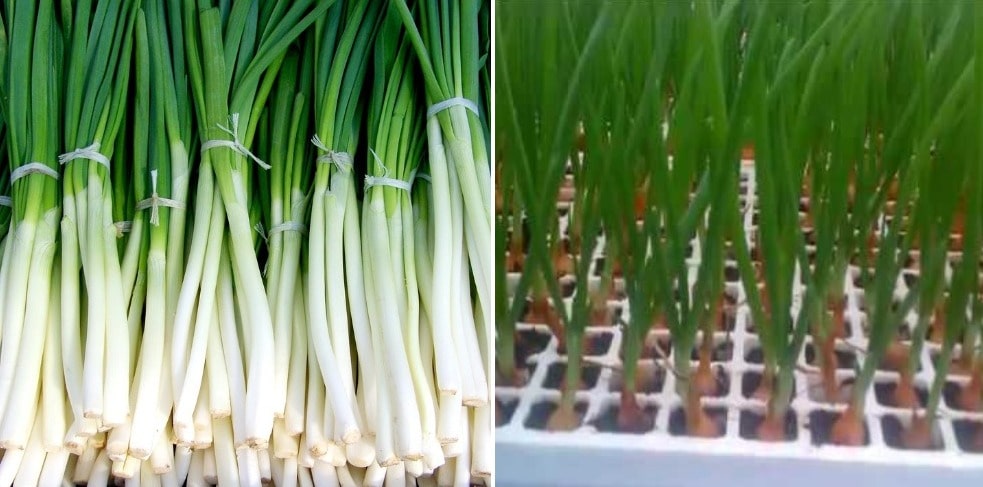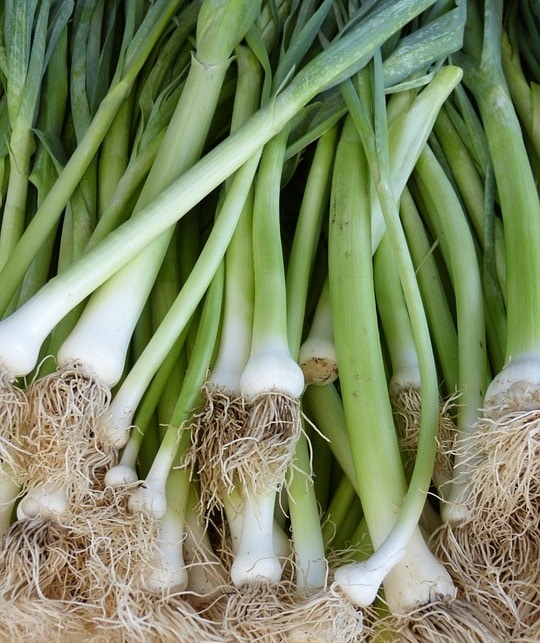A step by step guide of growing Hydroponic spring onions
Today, we discuss the topic of growing hydroponic spring onions and full details of nutrient solution required for spring onions. Spring onions are chef’s all-time favorite ingredients, as it gives beautiful definition and rich crispy flavor to any dish. Spring onions or green onions are usually costly as compared to the regular onions. Of course, everybody loves love tasty, versatile vegetables that only need minimal space and effort, for this undoubtedly spring onions are an excellent choice. Spring onions, or green onions or scallions, or whatever you like calling them, these little green plants are great for a hydroponic setup.
A lot of people get confused with word scallions and spring onions though there a little difference in these words, broadly they are considered the same. They are either harvested very young from the regular bulb-forming onions we are very much familiar with, or they can come from other special varieties that actually never form bulbs.
Scallions are long, hollow, with a white to green colored stem end that does not bulge out a bulb. They have an onion-like but mild flavor that is not as intense as regular onions. They are used raw or cooked, and while some cooks discard the darker green tops, the whole plant material can be eaten and is often used in Asian culinary.

Spring onions, on the other side, appears similar to scallions, but you will notice that they have small onion bulbs present at the base. These onions come from the varieties that produce bulbs and are basically more mature harvested versions of scallions. Traditionally they are planted as seedlings in the late fall and then harvested the next spring, thus the word “spring” in the name is used.
Spring onions are sweeter and have a distinct flavor than the regular onions, but the greens are stronger in flavor than scallions. The bulbs can be red or white, depending on the varietal character or stage at which it has been harvested, and while they can be used in much the same way as regular bulb onions.
So let’s get started how to grow hydroponic spring onions
In further writing, we will discuss growing green onions from scraps you can also check out YouTube how to grow spring onions for easy demonstrations and encouragement to start your spring onion hydroponic garden.
We know the first step of any gardening to be it hydroponics is to decide the starting material, for hydroponic, spring onion aquaponics spring onion seeds are best propagating material for a successful crop.
We know the first step of any gardening to be it hydroponics is to decide the starting material, for hydroponic, spring onion aquaponics spring onion seeds are best propagating material for a successful crop.
You may also check How to Grow Hydroponic Coriander.
Start from Soil or Grow Media
While you can start the spring onions in a hydroponic setup, some growers also prefer to first start them in the soil. After that, you can simply have a small furrow in the soil and insert bulbs or place seeds, and then when they sprout, you can move them to the desired hydroponic system. In this method one extra exercise you will need to do when transplanting the plants from the soil you must ensure to wash off any dirt or debris present on the seedling/ onion sets. This is an aseptic measure taken because unlike most of the component used for hydroponics production, the soil is not a sterile growth medium and it may also bring soil-borne diseases and pests to the hydroponic system which drastically affects the crop.
As a preventive method instead of soil you can use coco peat or coir, vermiculite like grow medium for the germination of onion seeds, before placing the seeds make sure the grow media is moistened using water and kept in on the windowsill so that it receives sufficient light to germinate.
Another famous method of propagating an answer to how to multiply green onions is using small mature onion bulb which is quicker than growing spring onions from seeds. These sets should be planted in the hydroponic substrate or grow medium with the top of the bulb approximately 1 inch below the surface. Green hollow shoots will rapidly develop from the pointed top of the set and roots will start to emerge from the base, and will be ready to be harvested in 80 to 95 days.
Hydroponic system
Spring onions offer great flexibility for choosing the hydroponic system in which it thrives. You can use any of the hydroponic systems as long as it allows the growth. Deep water culture system (DWC), ebb-and-flow system and floating raft bed are the most preferred system to raise hydroponic spring onions by experienced growers. Kratky green onions are also quite liked due to its simplicity and it provides much scope for modification and DIY. Nowadays aero garden green onions are also gaining fame because of its compact and portability. The only point to be noted when growing spring onion is the nutrient solution must be available to the developing bulbs along with support which will hold the growing bulb. A shallow about 6 inches reservoir also works well for growing spring onions.
You may also like How to Grow Moringa from Seeds, Cuttings.
Hydroponic spring onion nutrient solution
Spring onion does not demand any specialized nutrient mix it grows well on a standard vegetative formulation available at any online store with complete usage guide. Uplifting levels of nitrogen and sulfur in nutrient solution will boost the flavor and organosulfur compounds present in the plant.
Plants growing under stress, with high EC or low moisture levels in the substrate has been observed to concentrate flavor compounds in the plant but it may also induce premature bolting i.e. flower formation.
The ideal pH levels for hydroponic spring onions are best maintained at 6 to 6.5. They must have an EC in a range of 1.8 to 2.
To avoid the accumulation of undesirable salts and stagnated oxygen you should replace the hydroponic nutrient solution every four to six weeks. You can reuse the used drained solution into your flowerbeds or vegetable garden.
Sometimes spring onion plants or clumps become dense and under high humidity, this also invites fungal diseases. Selective elimination of older foliage, thinning spring onions especially when the seed has been directly sown and a good a level of airflow helps to prevent disease infestations.
In order to obtain a good supply of spring onions provide adequate light for your plants either sunlight or grow lights. Although green onions don’t have need of the abundance of light as needed by fruiting plants like tomatoes, they still have a preferred medium to high amounts of light about 12-14 hours. To facilitate this keep them in a sunny spot or provide them with fluorescent lighting or LED lights designed for growing plants.
Pests and Diseases of spring onions
When you are growing spring onions, thrips are the main pest to watch for. These devastating small sucking insects are usually active in the warmer months and most frequent in dry weather. To avoid this check the growth of the plant periodically. Though indoor hydroponic systems barely ever encounter pest problems occasionally pests and insects from outdoors make their way into the porch or grow room by human activity. Make sure your hydroponic system is moist enough but not waterlogged to avoid potential problems of fungal growth and insect-pest multiplication.
Harvesting

Your hydroponic spring onions will be ready to harvest in 80- 95 days after sowing seeds. You can easily harvest green onions by cutting the fresh hollow leaves when the tops reach 6 to 8 inches in length or by gently pulling the entire plant from the growing bed as you don’t need bulbs.
That’s all folks about ideas of growing hydroponic spring onions.
You may also check Chilli Farming Profit, Cost, Project Report.
Nice article. I’m starting to grow some now in my hydroponics system. I’m curious- what is the ideal temperature for growing spring onions?
Thanks for the info I’m really glad I found this I’m doing an experiment for a science fair. How does the pH level affect green onion growth?
Good day thank you for the article,
I did my first spring onion in a dam with floating trays
I gave it a hydrophinic fertilizer and kept the Ph over 6 and ec at around 2
the grew excelent and i harvested good
On my second batch the onions does not seem to be growing the roots and the leaves are not nice and green
Could it be an oxigen problem?
Your assistance will be highly appreciated.
It is an open dam with an inlet and outlet with a tank and pump for circulating the water and I add the fertilizer into the tank
kind regards